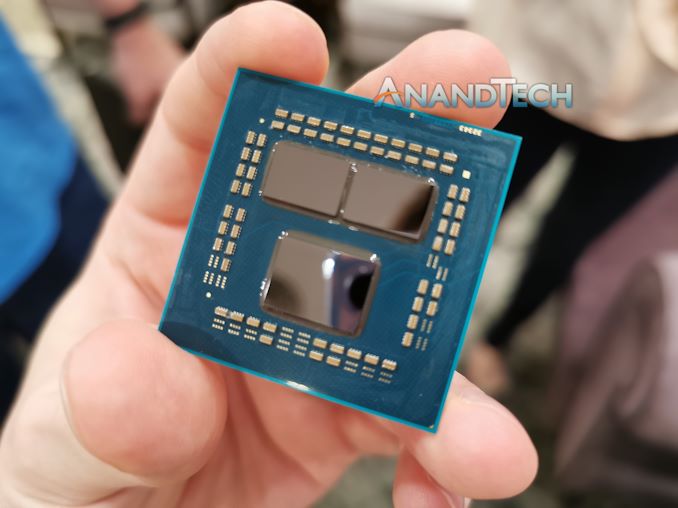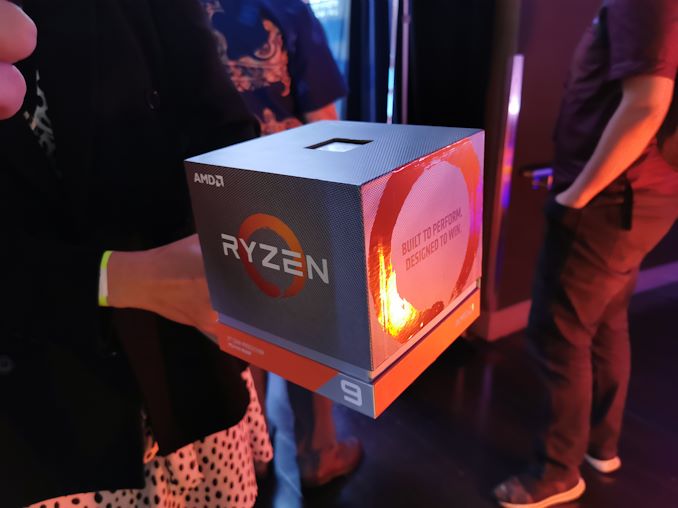AMD 16-Core Ryzen 9 3950X: Up to 4.7 GHz, 105W, Coming September
by Dr. Ian Cutress on June 11, 2019 6:00 PM EST- Posted in
- CPUs
- AMD
- Ryzen
- Zen 2
- Ryzen 3000
- Ryzen 3rd Gen
- Ryzen 9
- 3950X

One of the questions that was left over from AMD’s Computex reveal of the new Ryzen 3000 family was why a 16-core version of the dual-chiplet Matisse design was not announced. Today, AMD is announcing its first 16 core CPU into the Ryzen 9 family. AMD stated that they’re not interested in the back and forth with its competition about slowly moving the leading edge in consumer computing – they want to launch the best they have to offer as soon as possible, and the 16-core is part of that strategy.
The new Ryzen 9 3950X will top the stack of new Zen 2 based AMD consumer processors, and is built for the AM4 socket along with the range of X570 motherboards. It will have 16 cores with simultaneous multi-threading, enabling 32 threads, with a base frequency of 3.5 GHz and a turbo frequency of 4.7 GHz. All of this will be provided in a 105W TDP.
| AMD 'Matisse' Ryzen 3000 Series CPUs | |||||||||||
| AnandTech | Cores Threads |
Base Freq |
Boost Freq |
L2 Cache |
L3 Cache |
PCIe 4.0 |
DDR4 | TDP | Price (SEP) |
||
| Ryzen 9 | 3950X | 16C | 32T | 3.5 | 4.7 | 8 MB | 64 MB | 16+4+4 | ? | 105W | $749 |
| Ryzen 9 | 3900X | 12C | 24T | 3.8 | 4.6 | 6 MB | 64 MB | 16+4+4 | ? | 105W | $499 |
| Ryzen 7 | 3800X | 8C | 16T | 3.9 | 4.5 | 4 MB | 32 MB | 16+4+4 | ? | 105W | $399 |
| Ryzen 7 | 3700X | 8C | 16T | 3.6 | 4.4 | 4 MB | 32 MB | 16+4+4 | ? | 65W | $329 |
| Ryzen 5 | 3600X | 6C | 12T | 3.8 | 4.4 | 3 MB | 32 MB | 16+4+4 | ? | 95W | $249 |
| Ryzen 5 | 3600 | 6C | 12T | 3.6 | 4.2 | 3 MB | 32 MB | 16+4+4 | ? | 65W | $199 |
AMD has said that the processor will be coming in September 2019, about two months after the initial Ryzen 3rd Gen processors, due to extra validation requirements. The chip uses two of the Zen 2 eight-core chiplets, paired with an IO die that provides 24 total PCIe 4.0 lanes. By using the AM4 socket, AMD recommends pairing the Ryzen 9 3950X with one of the new X570 motherboards launched at Computex.
With regards to performance, AMD is promoting it as a clear single-thread and multi-thread improvement over other 16-core products in the market, particularly those from Intel (namely the 7960X).
There are several questions surrounding this new product, such as reasons for the delay between the initial Ryzen 3000 launch to the 3950X launch, the power distribution of the chiplets based on the frequency and how the clocks will respond to the 105W TDP, how the core-to-core communications will work going across chiplets, and how gaming performance might be affected by the latency differences going to the IO die and then moving off to main memory. All these questions are expected to be answered in due course.
Pricing is set to be announced by AMD at its event at E3 today. We’ll be updating this news post when we know the intended pricing.
Update: $749
Related Reading
- AMD Ryzen 3000 Announced: Five CPUs, 12 Cores for $499, Up to 4.6 GHz, PCIe 4.0, Coming 7/7
- AMD Ryzen 3rd Gen 'Matisse' Coming Mid 2019: Eight Core Zen 2 with PCIe 4.0 on Desktop
- AMD: 3rd Gen Ryzen Threadripper in 2019
- AMD Confirms PCIe 4.0 Not Coming to Older Motherboards (X470, X370, B350, A320)
- ASUS Pro WS X570-Ace: A No-Nonsense All-Black Motherboard with x8/x8/x8
- GIGABYTE Unveils X570 Mini-ITX Motherboard: X570 I Aorus Pro WiFi
- ASRock X570 Aqua: Heaviest AMD Flagship Motherboard Ever (Plus Thunderbolt)
- MSI Unveils the MEG X570 Ace: Black and Gold For AMD 50












172 Comments
View All Comments
Xyler94 - Tuesday, June 11, 2019 - link
Kill? No. HEDT is more than just core count. remember Zen2 goes up to 64 cores. They still have 24 and 32 cores to go into. And even if they release a 16 core Threadripper 3, I bet it will sell very well because of quad channel memory, and way more PCIe lanes to work with.This is just giving us a new high core count chip on "mainstream"
peevee - Wednesday, June 12, 2019 - link
They absolutely SHOULD release a 2-chiplet 16-core Threadripper if they are still going to limit this platform to 4 channels (while the socket supports 8).haukionkannel - Thursday, June 13, 2019 - link
They save best chiplets for Rome and 3950! The 6 and 8 core cpus gets the worst cpus They can find, because it does not matter if They eat more energy. The 16 core has ro have reasonable good cpu chiplet or it would run out of energy too early...ChubChub - Friday, June 14, 2019 - link
The way AMD boosts clocks is largely based on TDP/motherboard limitations; it's a very clever system that rewards superior cooling solutions. TDP can be adjusted, meaning your available boost clocks will adjust accordingly (assuming you have the proper cooling). The benefit of this system will be clear once the new AMD chips are compared against their Intel counterparts; Intel's heavy reliance on going way out of spec. will become (more) obvious.So, the 4.7GHz of the 16C chip is able to be advertised mostly because the base clocks are low, leaving a lot more headroom to boost specific cores to guaranteed 4.7GHz (most chips will likely boost above this, bone stock). If you take a 12C (8C) chip and mess with the chip's limitations, you'll see similar boost clocks.
TL;DR: Worry not, the 8C chips will be boosting in the same range as the 16C ones are, much like what is happening with the Zen+ parts.
mode_13h - Saturday, June 22, 2019 - link
AMD is probably binning their best dies for the 16-core part.I hope they eventually release an 8-core that turbos to 4.7 GHz.
Wise Wolf - Tuesday, June 11, 2019 - link
Wow you have to go down from a Ryzen 9 3950X to a Ryzen 7 3700X to go down in TDP from 105W to 65W, in Mini ITX builds where higher watts = more heat it can be pretty crucial. Im surprised that they dont decrease the wattage for all those disabled cores when you go down in cpu level. One other thing is that all the new X570 boards are HUGE! either Full ATX or E-ATX but I havent seen any Mini-ITX or Micro-ATX motherboards with X570 yet from any manufacturer.FMinus - Tuesday, June 11, 2019 - link
The 3800x was marked as 95W this show, but 105W at computer, but I believe 95 might be rightschujj07 - Tuesday, June 11, 2019 - link
Gigabyte has a mini-ITX.https://www.anandtech.com/show/14460/gigabyte-unve...
The 3950X will create less heat in an ITX space than either the 9700K or 9900K and people put those into ITX cases all the time.
Wise Wolf - Tuesday, June 11, 2019 - link
Thanks for that link, on a side note DAT BACKPLATE! is huge lolGreenReaper - Tuesday, June 11, 2019 - link
Well sure; instead of decreasing wattage; they're increasing base core clocks for sustained perf. Looks like there's a sweet spot somewhere around 3.5/3.6Ghz, which is why they put the 3700X and 3950X base there. 3600X, 3800X and 3900X have more headroom for a higher base clock. It won't use that all the time, but they only have three cooler models, so no sense in e.g. 80W TDP.Personally I think 3900X is the best value here. Twelve cores should be enough for a while, and you basically pay double to get two 3600Xs in one socket, with no compromise in base clock and +4.5% boost, perhaps thanks to the separation (though I want to see full clock/core progression). Having that extra cache will help keep up as newer software inevitably processes more data. 3950X is compromised by less L3 per core, and lower clocks, butting up against the 105W limit.
Obviously the 3600 is a great value in cores per dollar, and the clock speed is only 200Mhz lower. All things being equal, you should be able to overclock it to at least 3700X levels as well. But they're not; better-quality chiplets are likely to go to the higher-level CPUs, at least at first. You'll probably have to toss the 65W cooler it comes with to get much more out of it, too.
The 3800X doesn't make sense to me, unless you *really* want to avoid the potential impact of NUMA. You're paying the price for having a chiplet with all cores working and able to run at a reasonably high frequency, but losing out on 3900X's additional cores, cache, and higher boost.
Of course ultimately we need to wait for benchmarks. But it's no surprise that CPUs employing less-than-perfect 6-core chiplets offer a significant discount. The value there is unlikely to change.